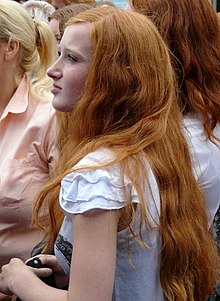Red hair
Red is a hair color that varies from deep mahogany red to copper and bold orange tones to reddish gold tones. The lighter variants are called reddish blond. The transitions towards chestnut brown on the one hand and golden blonde on the other are fluid. Exact definitions and designations of the various colour variations are not always easy and can differ both culturally and individually, especially in the fringe areas shown, just as the perception of other hair and eye colours can also differ depending on the environment (the same hair colour is often perceived somewhat differently and as lighter in southern countries than, for example, in northern Europe or northern Germany).
The predisposition for red hair is called rutilism. Only about one to two percent of the world's population has natural red hair. The most common cause is a variation on chromosome 16 that leads to a change in the protein MC1R: Instead of dark melanin, there is pheomelanin in the skin, hair and eyes, which also leads to sensitive, light-colored skin that can tolerate little or hardly any sunlight and, as a result, is more prone to sunburn and freckling. In terms of light sensitivity, many redheads are therefore relatively close to albinism compared to other hair colours.
Reddish hair, especially reddish blondes, can darken over time, although usually not as extremely as blondes. So redheads often have slightly lighter hair as children than they do as adults. The hair colour may then also appear somewhat duller and less luminous. Redheads usually turn grey much later than dark-haired people, often not until they are well over 50. The effect is then also at least initially less 'grey' than especially with dark hair types.
The facial and body hair of red-haired or red-blond people does not necessarily match exactly the color of the main hair, for example, eyebrows or eyelashes can be both lighter and darker. Conversely, there is also the phenomenon of a red or reddish beard in men, although the main hair color is different (e.g. brown, blond or dark blond). Probably the most famous example of this was Emperor Frederick I, who went down in history as Barbarossa ("Red Beard") because of his red beard.
Some people, who actually have a different hair colour by nature, especially some brunettes, show a reddish shimmer on their hair in sunshine or under special lighting conditions - but in the true sense of the word, this is not called "red hair".
In the animal kingdom, too, various reddish hues of hair occur, e.g. in squirrels, deer, foxes, horses, cats, dogs. In mammals, one speaks of the coat color.

The actor Seth Green, 2010

two girls with reddish blond and dark red hair, Breda 2011

Toddler with reddish hair
Term
In the German language, the hair color 'red' is not distinguished from the color red, although they are in fact completely different shades. In some other languages, however, there are different words for the color and the hair color, for example, the French word for the color red is rouge, while the hair color is called roux, and in the feminine, rousse. Similarly, in Portuguese, the hair color red is called ruivo, while the color red is called vermelho or encarnado. In the Cologne dialect red-haired means fuss or fussich (actually: fuchs (farben), fuchsig), a red-haired person is a Fussiger (fem. Fussige), Fusskopp or Fussköpp (fox-head, red-head), a red-haired child a Füsschen (little foot).
Colloquially, even light reddish-blond tones or chestnut-brown hair with only a small amount of red is often referred to as 'red'. In English, different reddish hair colors are sometimes linguistically clearly distinguished from each other, so the term strawberry blond (literally "strawberry blond") refers to a blond tone that has only a very slight reddish tinge - a hair color that has no precise definition in Germany. Very dark red is called auburn in English; it is more common in southern countries, such as Italy or Spain, but also in North Africa or Asia, than in the north. Ginger refers to a hair color that tends towards orange; however, the term is also used in a generalized way for red hair and also tends to have a negative connotation.
During the Renaissance, people (especially in Italy) had a preference for reddish-blond or red-gold hair, hence the term "Titian red".

A blonde that is only minimally reddish is called strawberry blonde.
Genetics
Red hair is inherited recessively, this means that even parents who are not red-haired themselves can invisibly carry the predisposition for rutilism in themselves and then pass it on. So even dark-haired or blond people without any red tinge in their hair can have a child with red or reddish hair, if they had a red-haired person among their ancestors at some time, and if both partners (parents) carry this predisposition. In this case, the chance of having a red-haired child is 25%.
Responsible for reddish hair and the often associated predisposition to sun-sensitive white skin is primarily the gene MC1R, which is located on chromosome 16, and which is also sometimes referred to as the "ginger gene" (after the English term ginger for orange-red hair). Ninety-two percent of all red-haired people have mutated copies of MC1R. The gene contains information for the melanocortin-1 receptor, which can lead to different hair colors. Various scientists, including Mark Stoneking and his team at the Max Planck Institute for Evolutionary Anthropology in Leipzig (MPI-Eva), found that MC1R occurs in more than 70 different variants, five of which have been identified as responsible for red hair (as of 2012).
The three most common gene variants for red hair are: 151-cysteine red (or R151C), 160-tryptophan red (or R160W), and 294-histidine red (or D294H). Other gene variants are much rarer, with allele frequencies of less than 2%. The 151-cysteine-red and 160-tryptophan-red gene variants are about 70,000 years old and are both thought to date back to ancestors in western Asia. 294-histidine-red is much younger and probably descends from a European who lived 30,000 years ago.
In addition, experts suspect that at least one other gene - HCL2 on chromosome 4 - may also play a role in red hair colour (as of 2012). In further research at the University of Edinburgh, a total of eight genes were found in an association study of the UK Biobank (as of 2018) that cause a form of red hair. SNPs on the MC1R accounted for 73% of these. Other loci were found on the POMC gene, which makes the prohormone for alpha-MSH, the ligand for melanocortin receptor 1. A deficiency in alpha-MSH, as well as a dysfunctional receptor, may explain the development of red hair. Another SNP points to ASIP, an antagonist of alpha-MSH at the receptor, so increased production of ASIP also leads to hair color red. Another SNP was found in the HER2 gene, which affects the transcription of OCA2, as well as a SNP in TSPAN10 that impedes the migration of melanocytes, which can lead to blonde hair in addition to red.
According to the English magazine Ginger Parrot, men with red beards, but who have a different color of head hair, do not carry the MC1R mutation in their DNA on chromosome 16, but on chromosome 4.
In modern forensics, redheads can be identified one hundred percent unambiguously on the basis of their MC1R gene. A corresponding DNA test was developed by forensic scientist Manfred Kayser at the Erasmus Universiteit Rotterdam. Brown and blond hair is only 80 percent detectable, black hair 90 percent.
Red hair, unlike other hair colors, has a large amount of the pigment pheomelanin. It is also said that redheads have only about 90,000 hairs, in contrast to blondes and brunettes, where it is calculated that they have about 100,000 to 120,000 hairs. On the other hand, red hair is a lot thicker and sometimes downright "wiry" - but this is less true of lighter shades of reddish blonde.
Some research suggests that redheads have abnormalities in the pain system, particularly an increased sensitivity to pain. Various scientists, including a team led by Edwin Liem from the University of Louisville in the US state of Kentucky, found that redheads require up to 20 percent more anesthesia for anesthesia until they no longer feel pain. Jeffrey Mogil of McGill University in Montreal and other scientists were also able to show "that red-haired women are more sensitive to cold and heat stimuli." Overall, however, there are also conflicting results on the perception of pain in redheads, and it seems that "certain forms of pain are perceived more strongly, while others are perceived more weakly."
Since the very light or white skin, which is usually coupled with red hair, has only a very small amount of the pigment eumelanin, higher vitamin D production occurs under sunlight. The gene for this receptor is also known as the extension locus. In addition, the risk of skin cancer due to sun exposure is much higher in redheads (similar to albinos) than in people with darker skin colour, because the UV rays of the sun can penetrate more easily to the cell nuclei and the DNA of the skin cells. This damages the genetic material and leads to cancer.
Based on a 2001 study of the ginger gene, it was hypothesized that Neanderthals may have had red hair and passed on this hereditary trait. A 2007 study analyzing Neanderthal DNA found that some Neanderthals were indeed red-haired, but that this was due to a mutation in the MC1R gene that could not be detected in modern humans.
Search within the encyclopedia